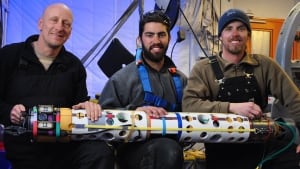If you think NASA loves acronyms, get a load of the multi-national ANtarctic geological DRILLing (ANDRILL) program’s Submersible Capable of under-Ice Navigation and Imaging (SCINI). Researchers in Antarctica sent the submersible through drill holes in the 250 meter thick Ross Ice Shelf to see what was underneath. You won’t believe what they found. A brand new species of sea anemone.
| A. Close up of Edwardsiella andrillae B. Field of specimens. Red dots are 10 centimeters apart C. Single specimen.doi:10.1371/journal.pone.0083476.g002 |
This was even more surprising because the expedition scientists were just planning to take ice samples, they did not expect to find any life under the ice and certainly not sea anemones. The researchers had to do some hasty improvising to examine and collect the anemone samples.
 |
| Members of an Antarctic drilling team, from left: Bob Zook, Paul Mahecek and Dustin Carroll, hold the underwater robot that was used to discover the sea anemone. (Frank Rack, CBC News) |
These sea anemones (Edwardsiella andrillae) actually burrow into the ice, dangling down into the frigid water below. They range in size from seven centimeters when fully extended to two centimeters when retracted into the ice. Although that sounds tiny, it’s actually quite large by burrowing anemone standards.
The fact that the researchers found fields of the anemones at two different drill sites (A and B below) strongly suggests that the creatures are extremely abundant under the ice. Marymegan Daly of The Ohio State University and Frank Rack and Robert Zook from the University of Nebraska-Lincoln found thousands of these hardy specimens.
| Drill sites A and B are roughly 6 kilometers apart. doi:10.1371/journal.pone.0083476.g002 |
No comments:
Post a Comment